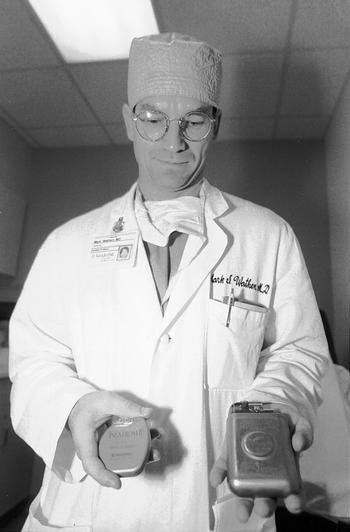New defibrillator may help eliminate 'false alarm' shocks

Dr. Mark Wathen with a standard-sized implantable cardiac defibrillator (right) and a new, smaller model (left) tested at VUMC. Photo by Donna Jones Bailey
The jolt from an implantable cardiac defibrillator may be a life-saver for patients with dangerous arrhythmias. But no one would describe it as a pleasant experience.
Unfortunately, as many as 20 percent of the electrical shocks delivered by these devices (ICDs) are not necessary. They are prompted not by life-threatening abnormal rhythms originating in the lower chamber of the heart, but by less-dangerous arrhythmias initiated in the upper chamber.
The problem is that most ICDs can't tell the two apart.
A new ICD ‹ also the world's smallest‹ is being tested at Vanderbilt University Medical Center and nine other centers across the country. This new ICD uses a technology developed at VUMC to distinguish between atrial (upper chamber) and ventricular (lower chamber) arrhythmias.
"As many as 25 percent of patients with ICDs also have abnormal rhythms from the upper chamber, so it's a very frequent problem," said Dr. Mark S. Wathen, assistant professor of Medicine.
"These devices deliver a severe shock ‹ some patients describe it as being suddenly hit in the chest or kicked by a horse. Moreover, some patients may experience a cluster of shocks, up to 60 over the course of a few hours, which can be physically demanding, if not psychologically devastating.
"There are some patients who develop such a fear of the next shock that they are willing to take the risk of dying by having the device turned off."
An ICD is a small electrical device implanted beneath the skin of the chest and attached to the heart with leads. The ICD monitors the heart's rhythm and shocks the heart back into proper beating sequence when an abnormally fast or sporadic rhythm occurs.
The importance of ICDs is this: the leading cause of death in the United States is cardiovascular disease, and the leading cause of cardiovascular death is the type of ventricular arrhythmias that ICDs are designed to address.
"If someone has had sudden cardiac arrest and has been shocked out of their ventricular arrhythmia, they have a 25-35 percent risk of recurrence over the next two years," Wathen said. "ICDs can reduce the incidence of sudden cardiac arrest to 2 percent per year."
Thus far, research has indicated that ICDs are particularly beneficial to patients with a history of ventricular tachycardia or ventricular defibrillation, which often result from heart damage after heart attacks or other heart muscle disease.
VUMC is one of 10 sites conducting a Phase 1 study of the new ICD, which is 30 percent smaller than its predecessor and dramatically smaller than ICDs available just a few years ago.
The smaller size is expected to reduce the risk of infection as well as make the device more comfortable for patients, Wathen said.
"The new device weighs 44 grams," Wathen said. "Ten years ago, ICDs started out in the order of 600-700 grams, so there's been a significant reduction in size. With that reduction, we've seen a decrease in infection."
Like all ICDs, the device continuously records electrical information in an electrogram, which provides a unique "footprint" of the patient's normal heart beat.
The new ICD determines which arrhythmias warrant a shock by comparing the footprint during the arrhythmia to a template of the normal rhythm.
"When the heart beat originates from somewhere other than its usual location, that footprint will be altered in a number of ways — the duration, the complexity, the sequence of positive and negative impulses," Wathen explained.
"A rhythm from the upper chamber, even if it's faster than normal, will match the normal footprint, so the device will know that a shock is not necessary."
Wathen said he expects that the device will eliminate a majority of unnecessary shocks, although because it will err on the side of caution, it will not eliminate all of them.
"It probably will provide about 75 percent discrimination, so the number of these so-called spurious shocks will be reduced by about 75 percent," he said.
The Phase 1 study, which will enroll 10-30 patients at VUMC, is open to anyone who has been determined to need an ICD. The trial is designed to determine the safety of the device and how effective it is at discriminating rhythm sources. All the patients who are enrolled will receive the new ICD.













